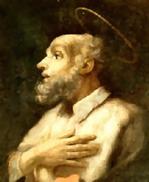Humble Hope In God, Rejoice In Him, The
1. The voice of a woman leads us today in the prayer of praise to the Lord of Life. In fact, in the story of the First Book of Samuel, it is Anna who sings the hymn we have just proclaimed, after offering her child, the little Samuel to the Lord. He was to be a prophet in Israel and his action was to mark the transition of the Hebrew people to a new form of government, monarchy, in which the unfortunate King Saul and the glorious King David would play the lead. Anna had a history of suffering in her past, for, as the story says, the Lord "had closed her womb" (I Sam 1,5).
In ancient Israel, a barren woman was considered as a withered branch, a dead presence, in part because she prevented her husband from having continuity in the memory of the generations to follow, an important factor in what was a hazy and uncertain vision of the hereafter.
2. But Anna had put her trust in the God of life and prayed: "O Lord of hosts, if you will indeed look on the affliction of your maidservant and remember me and not forget your maidservant, but will give your maidservant a son, then I will give him to the Lord all the days of his life" (I Sam 1,11). And God heard the cry of this humiliated woman and gave her Samuel: a living shoot that sprang from the dry trunk (cf. Is 11,1); what had been impossible in human eyes had become a tangible reality in that child who was to be consecrated to the Lord.
The hymn of thanksgiving that sprang from the lips of the mother was to be taken up and expressed anew by another Mother, Mary, who while remaining a virgin conceived by the power of the Spirit of God. In fact, in the Magnificat of the Mother of Jesus we can perceive an echo of Anna's canticle which for this reason is known as "the Magnificat of the Old Testament".
3. In fact, scholars note that the sacred author has placed on Anna's lips a sort of royal psalm laced with citations or allusions to other Psalms.
In the foreground, the image of the Hebrew king emerges, assailed by more powerful adversaries, but who in the end is saved and triumphs because the Lord who is at his side breaks the bows of the mighty (cf. I Sam 2,4). The finale of the canticle is significant, in which the Lord enters the scene in a solemn epiphany: "The adversaries of the Lord shall be broken to pieces; against them he will thunder in heaven. The Lord will judge the ends of the earth; he will give strength to his king, and exalt the power of his anointed" (v. 10). In Hebrew the last word is precisely "messiah", meaning "anointed one", which enables us to transform this royal prayer into a song of messianic hope.
4. We wish to underline in this hymn of thanksgiving two themes that express Anna's feelings. The first will also be dominant in Mary's Magnificat: it is the reversal of destinies that God brings about. The bows of the mighty are broken but the feeble "gird on strength". Those who were full have hired themselves out for bread, but those who were hungry sit at a sumptuous banquet with princes; the poor are raised up from the dust and given "a seat of honour" (cf. vv. 4.8).
In this ancient prayer it is easy to follow the thread of the seven actions that Mary sees accomplished in the history of God the Saviour: "He has shown strength with his arm, he has scattered the proud in the imagination of their hearts, he has put down the mighty from their thrones, and exalted those of low degree; he has filled the hungry with good things, and the rich he has sent empty away. He has helped his servant Israel ..." (Lk 1,51-54).
This is a profession of faith spoken by both mothers before the Lord of history, who arrays himself to defend the least, the poor and the suffering, the offended and humiliated.
5. The other theme we would like to highlight is connected even more closely with Anna: "The barren has born seven, but she who has many children is forlorn" (I Sam 2,5). The Lord who reverses destinies is also at the root of life and of death. Anna's sterile womb was like a tomb; yet God was able to make it bring forth life, because "in his hand is the life of every living thing and the breath of all mankind" (Jb 12,10). Immediately after, in this connection, Anna sings: "The Lord kills and brings to life, he brings down to Sheol and raises up" (I Sam 2,6).
At this point hope does not only concern the life of the child who is born, but also the life God can bring back after death. Hence an almost "paschal" horizon of resurrection opens. Isaiah was to sing: "Your dead shall live, their bodies shall rise. O dwellers in the dust, awake and sing for joy! For your dew is a dew of light, and on the land of the shades you will let it fall" (Is 26,19).
To the English-speaking pilgrims and visitors the Holy Father said:
I am pleased to offer warm greetings to all the English-speaking visitors present at this Audience. In particular, I greet the Delegation from the Ministry for Home Affairs of the Kingdom of Thailand. Upon all of you, especially those from Denmark, Japan and the United States of America, I invoke the joy and peace of our Lord Jesus Christ.
© L'Osservatore Romano, Editorial and Management Offices, Via del Pellegrino, 00120, Vatican City, Europe, Telephone 39/6/698.99.390.
This item 4208 digitally provided courtesy of CatholicCulture.org






